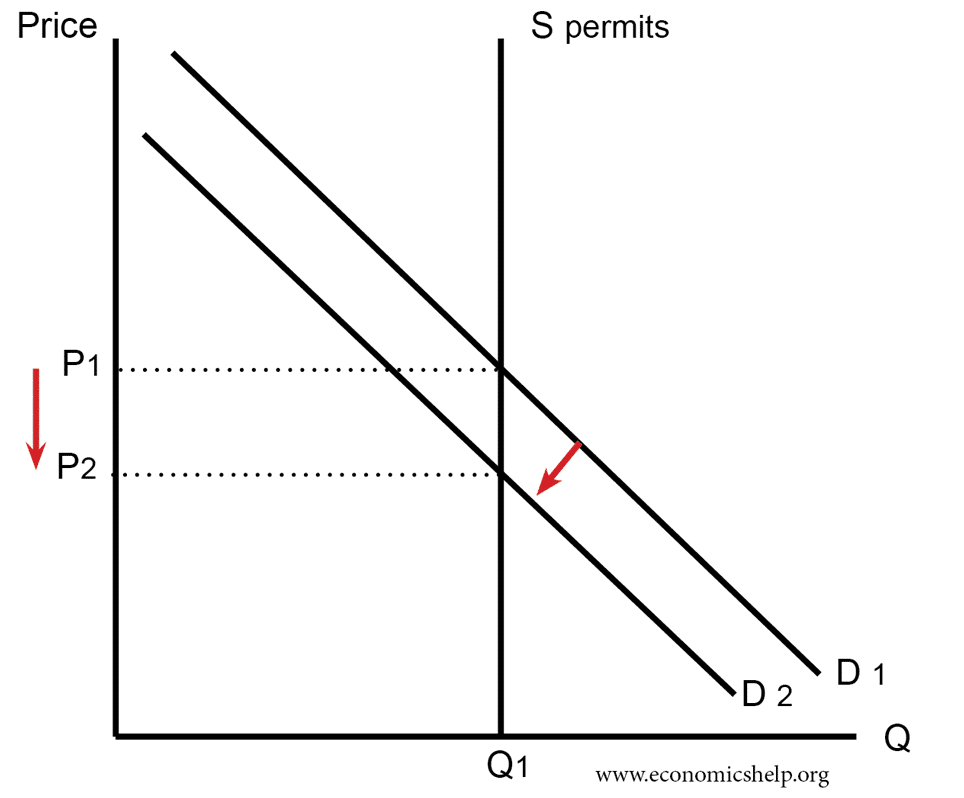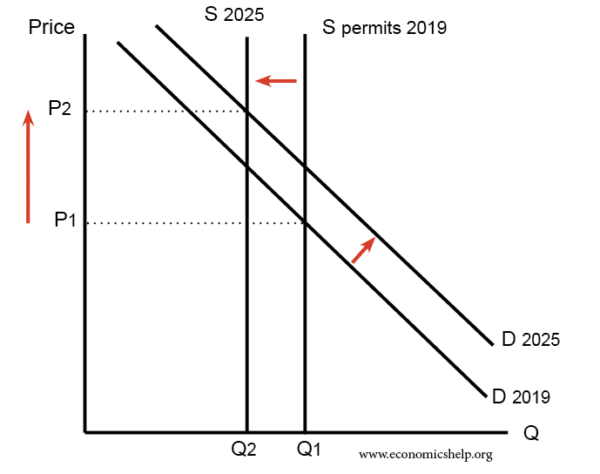- Pollution permits involve giving firms a legal right to pollute a certain amount e.g. 100 units of Carbon Dioxide per year.
- If the firm produces less pollution it can sell its pollution permits to other firms.
- However, if it produces more pollution it has to buy permits from other firms or the government.
- This creates a market for pollution permits with the price set by demand and supply.
- The aim of pollution permits is to provide market incentives for firms to reduce pollution and reduce the external costs associated with it. For example, it is argued carbon dioxide emissions contribute towards global warming.
- Pollution permits can also be a way for the government to raise revenue, by selling firms these permits to allow pollution.
Diagram for pollution permits with increased demand
A very simple diagram showing the fixed supply of pollution permits. Suppose there is rapid economic growth and the demand for producing pollution increases, the cost of tradeable permits rises from P1 to P2.
Pollution permit scheme with cut in supply of permits
In this case, the government reduces the number of permits over time. This means the price will steadily increase and create a growing incentive to reduce pollution over time. The idea is that it gives firms time to try and invest in different technology which creates less pollution.
Permits reducing demand over time
Over time, the existence of pollution permits should reduce demand for pollution. Firms wish to avoid paying the cost and find a way to reduce pollution. As demand for permits falls, the price of permits will fall.

In this case of falling price of permits, it may be necessary for the government to respond by steadily reducing the supply of permits. By steadily reducing the amount of permits, the government can steadily reduce the quantity of pollution.

In the long-term a fall in demand and fall in supply of permits leads to a decline in pollution.
Pollution permits and social efficiency
If firms produce carbon as a side-effect of production, it is classed as a negative externality. In this case, the social marginal cost of the polluting industry is greater than private marginal cost. In a free market, we get over-production of pollution and social inefficiency. (see: negative externality)
Pollution permits are a method to try and reduce output to a more socially efficient level. The aim is to make the price of pollution permits as close as possible to the social marginal cost
Pollution permits vs carbon tax
- Pollution permits have a similar goal to carbon tax. They both aim to increase the cost of producing pollution and create an incentive to reduce the quantity of pollution.
- The diagram on left shows how a tax can shift supply to the left and make firms pay the full social marginal cost of pollution. It raises the market price to P2.
- The diagram on the right shows how pollution permits have a similar effect. If the quantity of permits is set to Q2, the market price rises to P2
Problems of Pollution Permits
- It is difficult to know how many permits to give out. The government may be too generous or too tight.
- It can be difficult to measure pollution levels. There is potential for hiding pollution levels or shifting production to other countries, with looser environmental standards. In a globalised world, multinationals increasingly shift production around.
- There are administration costs of implementing the scheme and measuring pollution levels.
- For global pollution permits, countries who pollute more than their quotas can simply buy permits from other countries. Therefore rich developed countries can simply buy permits from less developed countries. This does not significantly reduce pollution but shifts it from the richer countries to poorer countries.
- The biggest carbon trading scheme is the EU Emissions Trading Scheme (ETS), however political interference has created a glut of permits and it has done little to reduce carbon dioxide and reverse global warming.
- Environmentalists have argued a higher price of carbon is insufficient to reduce carbon dioxide to levels necessary to stop global warming. Demand for carbon permits is often price inelastic and too slow to act.
- Some carbon trading schemes have a component called ‘carbon offsetting. This means if pay to plant trees, this can count against carbon emissions. However, critics argue carbon offsetting effectively enables firms to keep polluting with no guarantee planting trees will on their own solve the pollution problem.
Examples – Sulphur Trading scheme
In 1990, the US pursued a form of sulphur trading scheme which gradually reduced the number of permits to pollute sulphur. (a cause of acid rain).
- It was relatively straight-forward as sulphur emissions came predominantly from coal-burning power stations. This made it easy to monitor
- There was no scope for ‘sulphur offsetting’
- The scheme was successful in reducing sulphur dioxide by 40%.
- Though critics note sulphur dioxide also fell in other countries who pursued more standard regulatory legislation to limit the amount of pollution – rather than carbon trading.
China’s national cap-and-trade program
- The biggest carbon trading scheme will be in China, who have sought to learn from the EU’s experience with ERS
- The scheme will give a cap to polluters – this is the amount of pollution that can be created without cost. If polluters go above this ‘free’ cap, they have to buy allowances on the market for permits.
- The scheme set the initial carbon allowances to 3 -5 billion tones per year
Related



